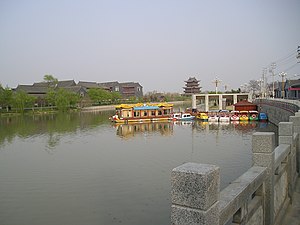| Chinese canal network | |||||||||
|---|---|---|---|---|---|---|---|---|---|
 | |||||||||
| Traditional Chinese | 漕運系統 | ||||||||
| Simplified Chinese | 漕运系统 | ||||||||
| Literal meaning | Canal Transport System | ||||||||
| |||||||||
The history of canals in China connecting its major rivers and centers of agriculture and population extends from the legendary exploits of Yu the Great in his attempts control the flooding of the Yellow River to the present infrastructure projects of the People's Republic of China. From the Spring and Autumn period (8th–5th centuries BCE) onward, the canals of China were used for army transportation and supply, as well as colonization of new territories. From the Qin (3rd century BCE) to the Qing (17th–20th centuries CE), China's canal network was also essential to imperial taxation-in-kind.[1] Control of shipbuilding and internal tariffs were also administered along the canals.[2]
- ^ Cheng, Linsun, ed. (2009). Berkshire Encyclopedia of China. Berkshire Publishing Group. p. 261. ISBN 978-0-9770159-4-8.
- ^ "The Significance of the Caoyun System in Imperial China (中国古代漕运的社会意义)" (in Chinese). Archived from the original on July 11, 2011. Retrieved November 15, 2010.
